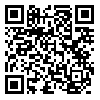Volume 72, Issue 11 (February 2015)
Tehran Univ Med J 2015, 72(11): 767-772 |
Back to browse issues page
Download citation:
BibTeX | RIS | EndNote | Medlars | ProCite | Reference Manager | RefWorks
Send citation to:



BibTeX | RIS | EndNote | Medlars | ProCite | Reference Manager | RefWorks
Send citation to:
Sharifinik M, Haji Abolhasan F, Jalaee S, Moradi V, Jafari M, Ghasemi Amir M. Hearing evaluation of infants with respiratory distress syndrome by TEOAE test. Tehran Univ Med J 2015; 72 (11) :767-772
URL: http://tumj.tums.ac.ir/article-1-6505-en.html
URL: http://tumj.tums.ac.ir/article-1-6505-en.html
Mahya Sharifinik * 
 1, Fahime Haji Abolhasan2
1, Fahime Haji Abolhasan2 
 , Shohre Jalaee3
, Shohre Jalaee3 
 , Vahid Moradi2
, Vahid Moradi2 
 , Mohsen Jafari2
, Mohsen Jafari2 
 , Mahdi Ghasemi Amir4
, Mahdi Ghasemi Amir4 


 1, Fahime Haji Abolhasan2
1, Fahime Haji Abolhasan2 
 , Shohre Jalaee3
, Shohre Jalaee3 
 , Vahid Moradi2
, Vahid Moradi2 
 , Mohsen Jafari2
, Mohsen Jafari2 
 , Mahdi Ghasemi Amir4
, Mahdi Ghasemi Amir4 

1- Department of Audiology, Tehran University of Medical Sciences, Tehran, Iran. , m-sharifinik@razi.tums.ac.ir
2- Department of Audiology, Tehran University of Medical Sciences, Tehran, Iran.
3- Department of Biology Statistic, Tehran University of Medical Sciences, Tehran, Iran.
4- Department of Industrial Engineering, Islamic University of KARAJ, Tehran, Iran.
2- Department of Audiology, Tehran University of Medical Sciences, Tehran, Iran.
3- Department of Biology Statistic, Tehran University of Medical Sciences, Tehran, Iran.
4- Department of Industrial Engineering, Islamic University of KARAJ, Tehran, Iran.
Abstract: (5491 Views)
Background: Respiratory distress syndrome is developmental immaturity of lungs, that is caused by lack of surfactant. Lack of surfactant lead to wide atelectasis and arterial hypoxemia which is a life-threatening lung disorder. The aim of this study was to compare the function of cochlear in infant who suffer respiratory distress syndrome with normal infants by transient evoked otoacoustic emission (TEOAE) test.
Methods: This descriptive- analytic cross sectional study was carried out on 21 respiratory distress syndrome (RDS) infants (42 ear) that consists of 11 male and 10 female, 21 normal infants (42 ear) that consists of 10 male and 11 female in Mirza Koochakkhan Hospital, Tehran University of Medical Sciences, Tehran, Iran, which all of them were 3 to 6 month year old, to collect informations about the health of infants we used the files in hospital and to assess the cochlear function we used computerized recording by TEOAE instrument. Statistical analysis carried out by SPSS software version 17 and Chi-square test.
Results: The results of TEOAE test demonstrated that in normal group there is no statistical differences between ears and gender, also there was no statistical differences between ears in respiratory distress syndrome group but there was statistical differences between gender in this group. The frequency of pass result (show normal function of outer hair cell in cochlea) was greater in male than female in male the frequency of pass result was 17 ear (77.3%) but in female was 8 ear (40%). In TEOAE test results there was statistical differences between two groups of study. The frequency of pass result in normal group was 34 ear (81%) and in respiratory distress syndrome group was 25 ear (59%) which was significantly more in normal group than in respiratory distress syndrome infants (P= 0.032).
Conclusion: According to results, it seems that the respiratory distress syndrome could affects the cochlear and the function of outer hair cell in it so in infants who suffer respiratory distress syndrome we should use the test battery of hearing.
Keywords: Cochlea, cross-sectional studies, hearing, Iran, otoacoustic emissions, respiratory distress syndrome
Type of Study: Original Article |
Send email to the article author
| Rights and permissions | |
 |
This work is licensed under a Creative Commons Attribution-NonCommercial 4.0 International License. |



